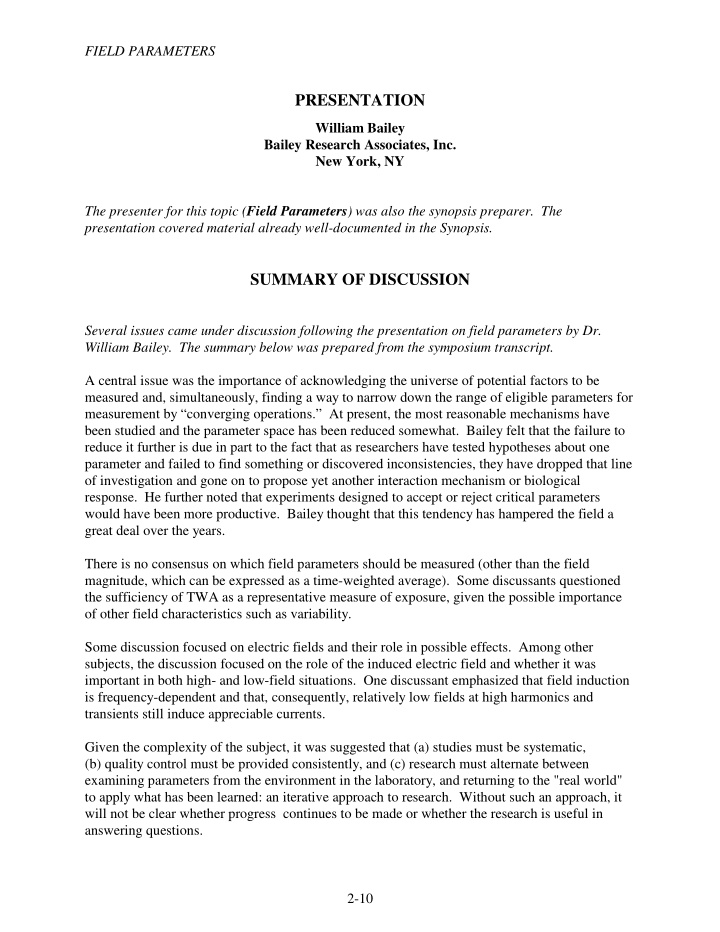



FIELD PARAMETERS PRESENTATION William Bailey Bailey Research Associates, Inc. New York, NY The presenter for this topic ( Field Parameters ) was also the synopsis preparer. The presentation covered material already well-documented in the Synopsis. SUMMARY OF DISCUSSION Several issues came under discussion following the presentation on field parameters by Dr. William Bailey. The summary below was prepared from the symposium transcript. A central issue was the importance of acknowledging the universe of potential factors to be measured and, simultaneously, finding a way to narrow down the range of eligible parameters for measurement by “converging operations.” At present, the most reasonable mechanisms have been studied and the parameter space has been reduced somewhat. Bailey felt that the failure to reduce it further is due in part to the fact that as researchers have tested hypotheses about one parameter and failed to find something or discovered inconsistencies, they have dropped that line of investigation and gone on to propose yet another interaction mechanism or biological response. He further noted that experiments designed to accept or reject critical parameters would have been more productive. Bailey thought that this tendency has hampered the field a great deal over the years. There is no consensus on which field parameters should be measured (other than the field magnitude, which can be expressed as a time-weighted average). Some discussants questioned the sufficiency of TWA as a representative measure of exposure, given the possible importance of other field characteristics such as variability. Some discussion focused on electric fields and their role in possible effects. Among other subjects, the discussion focused on the role of the induced electric field and whether it was important in both high- and low-field situations. One discussant emphasized that field induction is frequency-dependent and that, consequently, relatively low fields at high harmonics and transients still induce appreciable currents. Given the complexity of the subject, it was suggested that (a) studies must be systematic, (b) quality control must be provided consistently, and (c) research must alternate between examining parameters from the environment in the laboratory, and returning to the "real world" to apply what has been learned: an iterative approach to research. Without such an approach, it will not be clear whether progress continues to be made or whether the research is useful in answering questions. 2-10
FIELD PARAMETERS One commenter stressed the importance of integrating real-world findings with epidemiological and biological models to encourage convergence of the parameter space. It was further emphasized that, for a parameter to explain the epidemiology, it has to be observed in the real world, and it has to be correlated with exposure metrics used in epidemiology studies. Some commenters asked that any considerations of field parameters also address other factors that might be potential confounders in an epidemiology study. These include air pollution (present on highway or other transportation corridors with electric facilities), or other co-existing factors that might explain associations of health effects with (for instance) wire-code categories. These same comments emphasized the need to capture information about the real world of exposures and not simply to measure the magnetic field. Questions were also raised about the extent to which the electrical environment should be characterized in epidemiological studies: should radio frequency intensity, cell phone use, and other high-frequency exposures be incorporated? One commenter, following up on a question raised by Bailey, recommended that engineering researchers develop criteria by which to evaluate the engineering components of biological research and pass these on to medical and biological journals that might not have such expertise but that are involved in the review process for submitted papers. It was also suggested that a list of qualified reviewers be developed and circulated to journals (such as medical journals) that do not often publish in this area. One commenter suggested that three factors—current density, spatial variability, and temporal variability—should be included as exposure parameters. Another issue was whether electric-field research had been (unwisely or unfairly) abandoned in favor of magnetic-field research, which was characterized by some as "easier" to investigate. (Accurate measurement and characterization is more difficult for electric fields than for magnetic fields.) Some commenters stated that the shift in emphasis to magnetic-field research was strongly influenced by the results of epidemiological research in the area. In response to suggestions for a return to electric field research, one discussant pointed out that some research on electric fields is continuing, although it has been de-emphasized. For instance, electric fields are included in research in real-world occupational environments, if not in laboratory studies. Bailey indicated that magnetic fields were the more appropriate focus for the residential environment, but that both electric and magnetic fields should be considered in occupational environments. Submitted written comments on this topic are found in Appendix C. 2-11
FIELD PARAMETERS This page intentionally left blank. 2-12
Recommend
More recommend